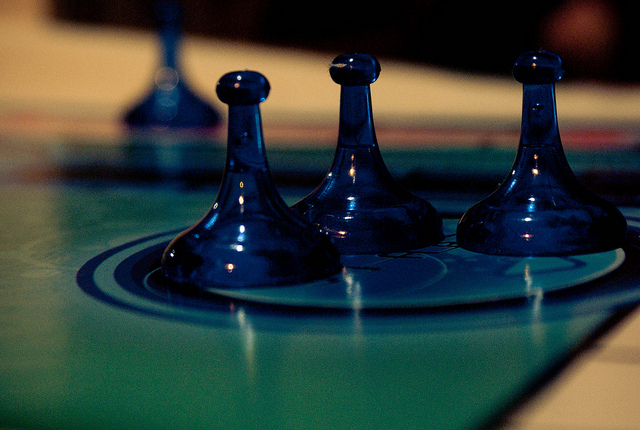
Do you ever walk away from a conversation and immediately replay (and regret) what you’ve just said? Torment yourself about a choice you made a long time ago that you wish you could erase? Obsess about something you should have done?
The only way to free ourselves from the grip of our past mistakes is not by shutting them out, but by letting them in.
It was five in the morning. (My six-year-old son begged me each night before bed to wake him up two hours before he had to get ready for school. He wanted to have time in his day to quietly do what he wanted.) We were sitting on the floor with a game of Sorry between us on the coffee table. He was taking his turn, and I was reading a book.
“It’s your turn, Mommy,” he said each time he finished. Halfway through the game, he stood up and said he didn’t want to play anymore. I tried to backpedal—I apologized—I begged him to come back and finish, promising to put the book down, but it was too late. He was on to something else.
He’s a teenager now—and roles are reversed. I desperately want more time, more connection with him, but he has other things to do. The memory of that game—the opportunity I had to be present with him and have a few moments of shared time together—haunts me.
The concept of forgiveness used to be appalling to me. I did not relish the idea of letting wrongdoings slide or go unnoticed. It felt like the only way to right a wrong was to totally ignore my feelings of injustice and pain.
Forgiveness means releasing the anger and blame we are holding against an offender. (In this case, ourselves.) There is a lot of encouragement to do this act of release, much of it from spiritual disciplines. Holding on to the vengeance we feel when a boundary has been crossed, even if we were the ones doing the crossing, goes against Ahimsa (non-harming)—the very foundation of yoga. It may seem like reliving painful past transgressions, although not pleasant, is harmless. This is a myth.
The more we keep regret inside and try not to think about it, the deeper we push it into our bodies and hearts where it accumulates and festers. Grudges can constrict us to the point of physical pain—and it is impossible to harm ourselves in this way and not have that harm affect others.
We have all seen the pretty quotes begging us to forgive for the sake of ourselves, others and the greater good. Promising us how much happier we will be, offering peace and love and calling on our strength of character. And yet—never telling us how.
So how do we do this thing called forgiveness? Certainly not by pretending, shutting out or forgetting. The only way to clear out our minds, hearts and bodies is to bravely shine a light on what’s in there—feel it and integrate it.
I am so very sad that I missed the opportunity for connection with my little boy. I’m angry that I was so wrapped up in my own stuff that I couldn’t see what I was missing. By holding onto this, I continue to berate myself and feel like I needed to prove my love for him. It feels like a gut-punch each time the memory sneaks into my awareness. But this is my hindsight version of what happened, which is different than what actually happened.
How do I reconcile this and make peace with it?
10 Steps to Self-Forgiveness.
1. Tell the story. Say it out loud. Write it down. Unlock all the awful details and let them out. Begin with: I can’t believe I ________.
2. Notice where it lives in your body. As you let your mind retell this incident, what physical sensations arise in response?
3. Fill in the blanks. I’m angry that______. I’m sad that______. These two emotions live in every regret.
4. Accept that it can’t be undone. No matter how many times we replay it in our heads or how strongly we try to bury it.
5. Identify the price you are paying. By holding onto this regret, how is it influencing you? How do you treat yourself when you recall it? How do you treat others?
6. Go back to who you were in the moment you did this. Who were you then? (Even if it was 10 minutes ago.) What were you thinking and believing? What was your physical state? What were you feeling?
7. Find compassion for your past self. Open to the possibility that given where you were mentally, physically and emotionally, you did what made sense to do at the time.
8. Merge. Instead of disowning the “you” who took this action, let her into your heart. As you unite with your past choices, the internal battle begins to cease.
9. Identify the experience. Or more specifically, identify the feeling state you believe you missed out on. What do you imagine you would have felt if you would have made a different choice?
10. Invite this feeling state into your life. By releasing the hold this regret has on you, you make room to experience what you weren’t able to then. You bring yourself into the present.
The woman who chose to read a book over playing a board game was an overtired mom of two young kids. She felt overwhelmed and depleted, with not a lot of time to herself. In that moment, she believed it was a win-win. Her son got to play the game, and she got some time to read. The fact that what he really wanted that morning was one-on-one time and attention was lost to her, until it was too late. She missed it—and it makes me sad. I may even be able to admit that I feel compassion for her and open my heart a little bit…
My son and I will not be connecting over a game of Sorry now. Those times are long gone. But if I can release my hold and make peace with my past self, I have the space and the opportunity for a new, different kind of connection. And just maybe, the ability to be present enough, so that I don’t miss it.
”Therefore, dark past, I’m about to do it. I’m about to forgive you—for everything.” ~ Mary Oliver
.
Author: Pamela Nauda Clark
Editors: Yoli Ramazzina; Catherine Monkman
Photo: Flickr/Amanda Govaert










Read 1 comment and reply